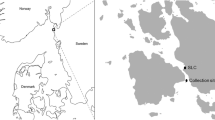Abstract
The food quality of detrital particles derived from three species of kelps was evaluated in a laboratory feeding experiment utilizing two species of suspension feeders, the serpulid polychaete Pseudochitonopomaoccidentalis and the mussel Mytilustrossulus. Fresh and aged kelp particles were also evaluated, and growth in all treatments was compared to growth on ad libidum phytoplankton rations. Fresh particles from Laminariagroenlandica, aged particles from Agarumfimbriatum and Alariamarginata, and mixed phytoplankton promoted the highest growth rates in both consumers. Growth was inversely related to total polyphenolic concentration in the fresh kelp particles. The increase in quality of both Agarumfimbriatum and Alariamarginata particles with age corresponded with a rapid loss of polyphenolic secondary metabolites and an increase in total nitrogen.
Similar content being viewed by others
Author information
Authors and Affiliations
Additional information
Received: 26 November 1996 / Accepted: 9 January 1997
Rights and permissions
About this article
Cite this article
Duggins, D., Eckman, J. Is kelp detritus a good food for suspension feeders? Effects of kelp species, age and secondary metabolites. Marine Biology 128, 489–495 (1997). https://doi.org/10.1007/s002270050115
Issue Date:
DOI: https://doi.org/10.1007/s002270050115




